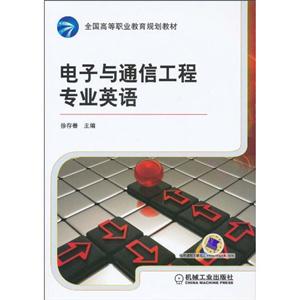-
>
西班牙语词根宝典
-
>
英语大书虫世界经典名译典藏书系:中国人的精神 (英汉对照)(精选权威版本)
-
>
许渊冲译唐诗三百首:汉文·英语
-
>
四级词汇词根+联想记忆法:乱序版
-
>
The secret garden
-
>
英国文学名篇选注
-
>
许渊冲译千家诗
电子与通信工程专业英语 版权信息
- ISBN:9787111313557
- 条形码:9787111313557 ; 978-7-111-31355-7
- 装帧:暂无
- 册数:暂无
- 重量:暂无
- 所属分类:>>
电子与通信工程专业英语 本书特色
《电子与通信工程专业英语》:全国高等职业教育规划教材
电子与通信工程专业英语 目录
电子与通信工程专业英语 节选
《电子与通信工程专业英语》由电子技术基础、通信技术、计算机技术和电子与通信工程四部分组成,共有26个单元。每单元包括课文、生词与短语、注释、练习、翻译技巧和阅读材料,内容多取材于原版的专业资料或专业英语教科书,语言真实地道,内容生动新颖,联系职业实际,应用性强,有助于从不同侧面有针对性地培养学生的专业英语实用技能,提高学生阅读和翻译英文技术文献与专业资料的能力,以及在一定场景下用英语进行交流的能力。书后附有部分习题答案和参考译文,便于帮助学生理解和检查自己所掌握的内容,在一定程度上减轻了学习的难度。《电子与通信工程专业英语》适合高职高专(含成人教育学院)电子技术、电子通信类专业和计算机控制等专业的学生使用,也可供相关专业的工程技术人员参考学习,或作为中等职业学校相关专业的学生用书。
电子与通信工程专业英语 相关资料
插图:Insulators generally have very stable atomic structures, of which the 4-electron outer-ring structureis typical. In such a structure, there is an absence of easily removed electrons. Examples of goodinsulators are certain compounds of carbon and diamond, which has a similar atomic structure.Semiconductors are a group of materials, which conduct electrons poorly and therefore cannotproperly be classified either as conductors or insulators. Generally, semiconductors differ frominsulators in that their outer-ring electrons can detach themselves from their orbits more easily thanin insulators. Typical semiconductors materials are germanium and silicon.Impurities may be added to pure semiconductors. This results in semiconductor materials,which may either have an excess of free electrons or a deficiency of orbital electrons. When anexcess of electrons is present we call the material N-type; when lack of orbital electrons occurs,we call the material P-type. Both N-type and P-type semiconductors are made by treatedmaterials. The addition of impurities to semiconductors is called doping.
- >
伯纳黛特,你要去哪(2021新版)
伯纳黛特,你要去哪(2021新版)
¥15.9¥49.8 - >
巴金-再思录
巴金-再思录
¥14.7¥46.0 - >
朝闻道
朝闻道
¥8.8¥23.8 - >
李白与唐代文化
李白与唐代文化
¥8.9¥29.8 - >
伊索寓言-世界文学名著典藏-全译本
伊索寓言-世界文学名著典藏-全译本
¥9.3¥19.0 - >
人文阅读与收藏·良友文学丛书:一天的工作
人文阅读与收藏·良友文学丛书:一天的工作
¥14.7¥45.8 - >
自卑与超越
自卑与超越
¥12.7¥39.8 - >
莉莉和章鱼
莉莉和章鱼
¥13.4¥42.0
-
4.23文创礼盒A款--“作家言我精神状态”
¥42.3¥206 -
4.23文创礼盒B款--“作家言我精神状态”
¥42.3¥206 -
一句顶一万句 (印签版)
¥40.4¥68 -
百年书评史散论
¥14.9¥38 -
1980年代:小说六记
¥52.8¥69 -
中图网经典初版本封面-“老人与海”冰箱贴
¥20¥40





















